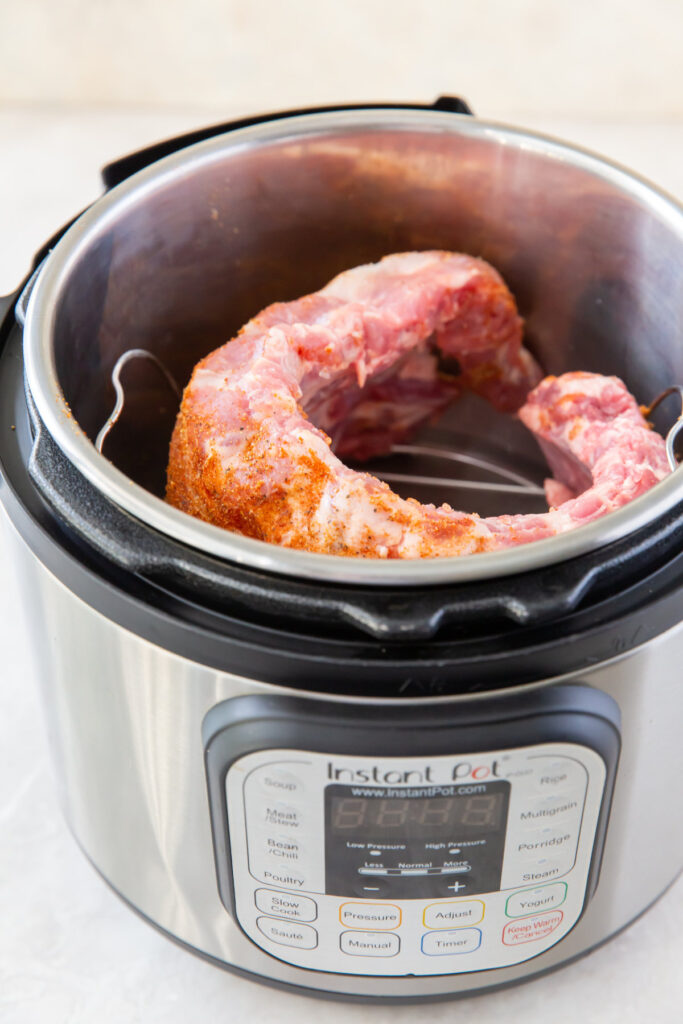Why Is My Meat Tough in a Pressure Cooker?
If you own a pressure cooker, you’re familiar with its ability to cook meals quickly and efficiently.
However, there may be times when your meat turns out tough and chewy instead of tender and juicy.
In this article, we will delve into the possible reasons why your meat might be tough in a pressure cooker.
We’ll also provide valuable tips to ensure that your pressure-cooked meat turns out juicy and delicious.
Why Meat Is Not Tender When Cooked in a Pressure Cooker?
Meat consists of muscle fibers that are held together by collagen, a connective tissue that gives structure and strength to the meat.
This is what makes it tough and chewy.
Collagen breaks down and converts into gelatin when cooked slowly at low temperatures for an extended period, resulting in tender and moist meat.
However, when meat is cooked quickly under high pressure, the collagen doesn’t have enough time to fully break down, leading to a tough and chewy texture.
Factors Contributing to Tough Meat in a Pressure Cooker
1. Insufficient Cooking Time
One of the primary reasons for tough meat in a pressure cooker is not giving it enough time to properly tenderize.
Pressure cookers drastically reduce cooking time, but certain cuts of meat with more connective tissue require longer cooking durations to break down the collagen effectively.
2. High Cooking Temperature
While pressure cookers operate at high temperatures, it’s crucial to ensure that you’re using the appropriate heat settings for different types of meat.
Exposing meat to excessively high heat can cause it to toughen rather than tenderize.
3. Improper Meat Cuts
Choosing the right cut of meat plays a vital role in achieving tender results.
Tough cuts, such as chuck roast or brisket, contain more connective tissue that needs extra time to break down.
Cook cuts recommended for pressure cooking, like chuck-eye, short ribs, or shanks.
4. Lack of Liquid
Sufficient liquid is necessary for creating steam and maintaining the pressure required for cooking in a pressure cooker.
Without an adequate amount of liquid, the meat can become dry and tough.
Follow the recommended liquid ratios in your pressure cooker’s instruction manual or recipe guidelines.
5. Preventing Natural Pressure Release
When cooking meat in a pressure cooker, it’s important to allow for natural pressure release after the cooking time is complete.
Forcing the pressure to release quickly can cause the meat fibers to contract abruptly, resulting in toughness.
Steps to Tenderize Meat Using a Pressure Cooker

To properly tenderize meat in a pressure cooker, follow these steps:
Step 1: Add Liquid
Pour a flavorful liquid, such as broth, stock, or wine, into the pressure cooker.
The liquid will help infuse moisture and flavor into the meat during the cooking process.
Step 2: Insert Meat and Seal
Place the seasoned meat into the pressure cooker, ensuring it is fully submerged in the liquid.
Next, securely seal the pressure cooker.
Step 3: Set Cooking Time and Pressure
Adjust the cooking time and pressure settings on your pressure cooker based on the type and size of the meat.
Longer cooking times and higher-pressure levels are generally required for tougher cuts of meat.
Step 4: Cook Under Pressure
Place the pressure cooker on the stove or select the appropriate cooking mode for an electric pressure cooker.
Allow the meat to cook under pressure until the desired tenderness is achieved.
Step 5: Natural Release or Quick Release
Once the cooking time is complete, you have two options for releasing the pressure: natural release or quick release.
Natural release involves allowing the pressure to decrease naturally over time, while quick release involves manually releasing the pressure.
The time you have will determine how long to wait before opening the pressure cooker.
Tips to Ensure Tender Meat in Your Pressure Cooker
- Choose the Right Meat Cuts
- Marinate your meat before pressure cooking or tenderizing it with a meat mallet.
- Adjust Cooking Time depending on the type and cut of meat.
- Add Sufficient Liquid to create the required steam and maintain proper pressure.
- Allow the pressure to release naturally after cooking to avoid sudden contraction of the meat fibers.
Frequently Asked Questions
Q1: Can I use frozen meat in a pressure cooker?
Yes, you can use frozen meat in a pressure cooker.
However, keep in mind that the cooking time may be longer as the frozen meat needs additional time to thaw and reach the desired temperature.
Q2: How can I make my meat more flavorful in a pressure cooker?
To enhance the flavor of your meat, consider using aromatic herbs, spices, and seasonings in your pressure cooker.
This will infuse the meat with delightful flavors while it cooks.
Q3: Can I open the pressure cooker during cooking to check the meat’s tenderness?
It’s generally recommended to avoid opening the pressure cooker during the cooking process, as it can disrupt the cooking time and temperature.
Opening the cooker can cause a loss of pressure and result in unevenly cooked meat.
However, if necessary, you can release the pressure carefully and check the meat’s tenderness before continuing to cook if needed.
Q4: Why does my pressure-cooked meat have a rubbery texture?
A rubbery texture in pressure-cooked meat is often a result of overcooking.
Ensure that you follow the recommended cooking times and adjust as necessary for your specific recipe and desired tenderness.
Q5: Can I use a pressure cooker for all types of meat?
Yes, a pressure cooker can be used for various types of meat.
Q6: How long does it take to tenderize meat in a pressure cooker?
The cooking time depends on the type and size of the meat.
On average, most cuts of meat require around 30 minutes to 1 hour of pressure-cooking time.
Q7: Can I add vegetables or other ingredients along with the meat to the pressure cooker?
Yes. Pressure cookers are excellent for one-pot meals.
You can add vegetables, potatoes, or other ingredients to create a complete and flavorful dish.
Conclusion: Unlock the Potential of Your Pressure Cooker
Tenderizing meat in a pressure cooker is a simple and effective technique that can transform even the toughest cuts into succulent and flavorful dishes.
The cooking process can be convenient and time-saving if you understand how to achieve the desired tenderness.
By following the steps outlined in this guide, you’ll be able to achieve juicy and tender results every time.
Don’t let tough meat ruin your meals – unleash the power of your pressure cooker and elevate your culinary skills.
Don’t have a pressure cooker yet? Consider getting yourself a reliable pressure cooker and transform your cooking.
I would recommend an instant pot which provides endless cooking possibilities.
Happy cooking!


